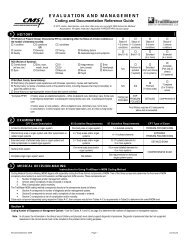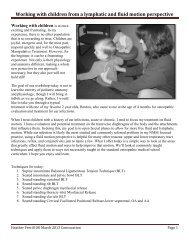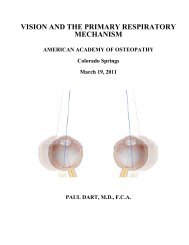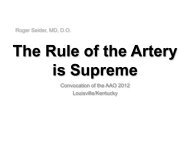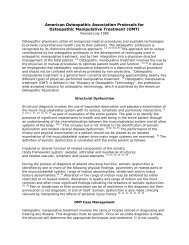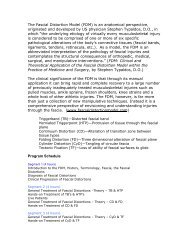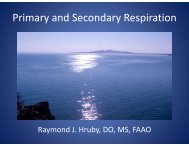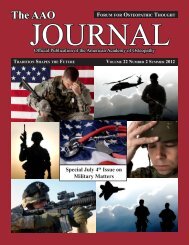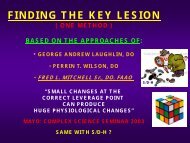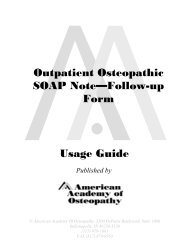Stiles - American Academy of Osteopathy
Stiles - American Academy of Osteopathy
Stiles - American Academy of Osteopathy
Create successful ePaper yourself
Turn your PDF publications into a flip-book with our unique Google optimized e-Paper software.
ii. Holding each segment in neutral, introduce flexion and extension from<br />
above (passive process on the patient’s part, active on yours). If the<br />
palpable tissue texture changes do NOT disappear the segment is a key<br />
lesion. If they do disappear in either flexion or extension the segment<br />
is NOT a key lesion.<br />
iii. For ribs the same principal applies except you use sidebending. Again<br />
if the tissue texture changes fail to disappear the rib dysfunction is a<br />
key lesion.<br />
iv. Pelvic dysfunctions are rarely key lesions but again if the signs <strong>of</strong> a<br />
dysfunction (ASIS or PSIS displacement) disappear with induced<br />
sidebending the dysfunction is not a key lesion.<br />
v. Key lesions are likewise rare in the extremities but seem to be made<br />
visible with axial rotation.<br />
5. Evaluate key lesions for exact nature <strong>of</strong> restrictions and exact positions <strong>of</strong> ease<br />
a. This is very important. However you should have already determined these<br />
factors when you first performed you somatic dysfunction list.<br />
6. Set body into position <strong>of</strong> ease for lowest key lesion<br />
7. Stack each additional key lesion in its position <strong>of</strong> ease on top <strong>of</strong> all lower one(s)<br />
8. Introduce compression from site above the top key lesion. Focus the compression on<br />
the top key lesion.<br />
9. Use this force vector to carry the top key lesion from its ease through its restriction<br />
10. Without removing the compressive force shift its focus to the next inferior key lesion<br />
a. Carry each successive key lesion from its ease through restriction<br />
11. Re-evaluate the whole body for somatic dysfunctions. Typically all will have been<br />
successfully treated.<br />
12. Alternatively you can try Dr. <strong>Stiles</strong>’ version and use a force vector my<strong>of</strong>ascial release<br />
focused on the AGR. Both versions produce comparable results.<br />
a. Both treat all somatic dysfunctions and their concomitant neural and vascular<br />
restrictions in a single rapid but complex dance.<br />
b. Still-Laughlin is very efficient, but treats everything the more fractionated<br />
methods like HVLA, Muscle Energy, Counterstrain, and Still Technique do.<br />
c. Still-Laughlin is not limited as to the type <strong>of</strong> tissue treated although its focus<br />
is on the musculoskeletal system.<br />
d. Accepting that most disease processes are due to body-wide dysfunctions, an<br />
integrated whole body treatment such as Still-Laughlin should be incredibly<br />
efficient in removing or reducing the musculoskeletal load contributing to<br />
disease and prevent the body from efficiently healing.




